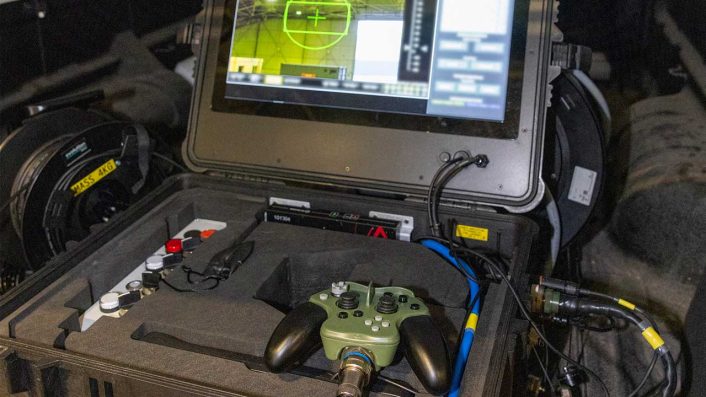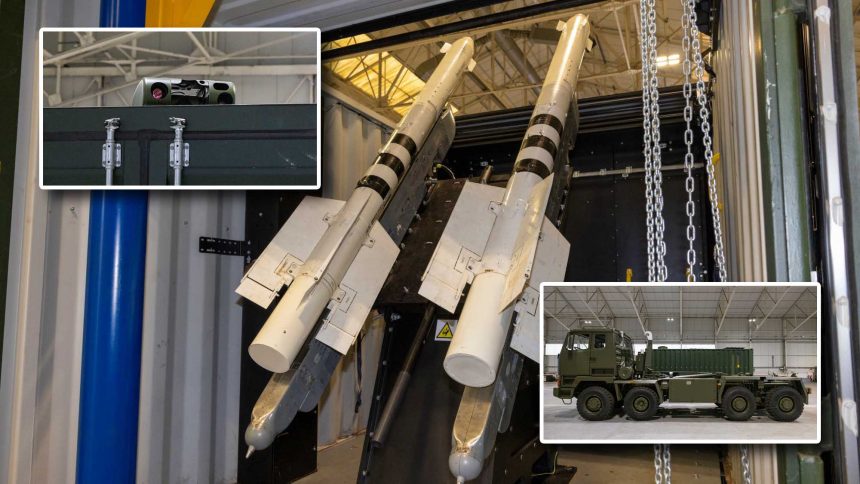Utilising existing Ukrainian stockpiles of Soviet designed R-73 air to air missiles, the Gravehawk is a containerised surface to air missile (SAM) system designed and produced within a 12 month period.
Conceptualised by British military forces, Ukraine was reportedly initially skeptical of the idea, but having now seen it in use are eager to receive more. According to British Ministry of Defence (MoD) sources speaking to reporters, two Gravehawk systems have already been shipped to Ukraine and have been actively deployed. A further 15 are expected to arrive over the next year.
The missiles are launched from a standard ISO sized shipping container, which also includes electrical generators and an electro-optical/infrared targeting camera. The container is compatible with widely used hook-loading trucks for easy deployment. A crew of five personnel can target and fire the missiles remotely from a portable control unit connected to the container by a 50 metre cable.

As a short-range missile, the Mach 2.5 R-73s of the Gravehawk system are intended primarily to engage small drones and cruise missiles that threaten Ukrainian forces and cities. This includes the infamous Iranian-designed Shahed suicide drone. Guided by passive infrared, the system does not carry the same risk as longer range surface to air missile batteries which can be located when active by tracing their radar emissions.
The SAM’s development was spearheaded by the MoD’s Taskforce Kindred, who are in charge of identifying and coordinating ways that the British military can provide support to Ukraine. A number of defence industry partners were involved in the design and construction, but the MoD says it is unable to publicly specify them by name. In total, the project cost around £6 million ($7.5 million). Each system has a reported cost of around £1 million ($1.2 million). Denmark have also apparently contributed to the system’s funding.
New British Gravehawk air defense system, designed for Ukraine.
Housed in a standard ISO container, it can be quickly deployed on a Leyland DAF 8×6 Drops truck or similar.
The five-person crew operates two P-72 rail launchers inside the container, firing adapted Soviet R-73… pic.twitter.com/uD3Z07IV3n
— Clash Report (@clashreport) February 12, 2025
The R-73 recently achieved a major success when a Ukrainian unmanned surface vessel equipped with two of the missiles engaged and shot down a Russian Mi-8 transport helicopter. This victory may have played into Ukraine’s changing mind on the utility of the Gravehawk SAM.
Weapon pylons from Soviet designed fighter aircraft were reportedly used for the launch rails that carry the missiles. Incompatibility between Soviet designed and NATO standard weapon rails has been widely reported throughout the conflict, with particular attention paid every time a new Western weapon is used on a Ukrainian aircraft to how the weapons have been mated to the aircraft.
A similar makeshift short range SAM, but using MBDA AIM-132 Advanced Short Range Air to Air Missiles (ASRAAMs), was provided by the UK to Ukraine in 2023. This system has reportedly achieved a 90% hit rate in combat service.
Additional UK Aid
The 26th Ukraine Defence Contact Group meeting was held at the NATO Headquarters in Brussels on Feb. 12, 2025. For the first time, the meeting was chaired not by the U.S. Secretary of Defense, but by UK Secretary of State for Defence John Healey MP.
I’ve just arrived in Brussels for important discussions with allies and partners over the coming days.
We will step up support for Ukraine, boost deterrence through NATO, and secure peace through strength. pic.twitter.com/VVLTUtkcWq
— John Healey (@JohnHealey_MP) February 11, 2025
Speaking to the delegates of many of the 57 nations that comprise the Ukraine Defence Contact Group, Healey affirmed that “2025 is the critical year for the war in Ukraine”. He added: “Ukrainians continue to fight with huge courage – military and civilians alike, and their bravery – fused with our support – has proved a lethal combination.”
To date, Healey confirmed that the UK had shipped over 500,000 rounds of ammunition to Ukraine since the beginning of the full-scale invasion, and that the UK is also on track to meet a target of providing 10,000 drones to Ukraine over the course of a single year.
A new firepower package, worth £150 million, will include thousands more drones alongside dozens of armoured vehicles. Modernised T-72 main battle tanks will also be delivered in the coming months.
Support contracts to facilitate the ongoing use of UK-supplied equipment by Ukrainian forces will see Babcock International train Ukrainian personnel to service and maintain Challenger 2 main battle tanks and other armoured vehicles. BAE Systems, meanwhile, has been awarded a maintenance contract for Archer self propelled artillery systems which will see their servicing take place within Ukraine, minimising their time spent away from the frontlines and reducing the transport burden.
The Times reports that 12 of the 14 Challenger 2 tanks donated to Ukraine are still serving on the front lines. While their rifled guns (requiring unique ammunition) and heavy weight have been a cause for skepticism among commentators, the Ukrainian crews working with the Challenger 2 have labelled it a “very powerful machine” with a ‘sniper’ gun.
🇬🇧🇺🇦 | British-made Challenger 2 main battle tank operated by the Armed Forces of Ukraine on the move somewhere on the Kursk front. pic.twitter.com/2xdZEuGwVp
— Status-6 (Military & Conflict News) (BlueSky too) (@Archer83Able) February 7, 2025
However, it is also noted that the tank’s 1200 horsepower V12 diesel engine frequently requires maintenance. Compared to tanks of a similar weight and class, the Challenger 2 is short by around 300 horsepower, and this difference is reportedly noticeable. Alongside a switch to a NATO standard 120mm smoothbore gun, the Challenger 3 upgrade due to enter service with the British Army will also see a switch to a 1500 horsepower engine.









